nobilisbellator
I loved this shit, it's so colourful!"Hahaha, the above text was rejected for being too short. Kate did warn us about rules didn't she."
litl-37444
I like Cate Blanchett as an actress basically, but I find the film pretentious, this is not done with the film language, there is no story in it. The work is an "art" itself, more like mixture of critical documentary and "experimental" poetry. Cinema may not be a good place to be shown, but the art gallery.
maurice yacowar
Manifesto is a manifesto about the ambition and limitations of artists' and philosophers' manifestos about art. Call it an anti-manifesto.In their setting and delivery most of the theories about art-making here are presented lightly, ironically. Their earnestness is especially amusing,Perhaps the one exception is the first. The Trump presidency — especially in the week of the Houston floods — gives an electric currency to Karl Marx's declaration of the deadliness and death of capitalism and the call for artists to lead a revolution. The film is framed by the Marxist call to arms and the final manifesto, an antithetic preference for tradition over individual imagination that turns restrictive.Still, that last episode provides the clearest representation of the beauty of life and the danger of restrictive art theory. Perhaps the film's most touching image is the tracking shot along the Grade III students' faces at their desks, especially the first three girls with their insecurity, uncertainty, fear. They are the future for which all the manifestos intend to prepare. The teacher assigns their film-scripting with a license to steal their ideas from anywhere. She cites Godard: "It doesn't matter where you take things from, but where you take them to." She seems thus to give her charges total freedom for their creativity. But as she visits each student's project she drops another restriction. No props are allowed. You must use fixed lighting. The director may not be named. Like every manifesto, her every specific direction is a restriction, not a freeing. The students' real "liberation" comes when they're freed from their ostensibly "creative" class. Now the camera pans across the schoolyard where the children break into play, some in pairs or groups, some by themselves. They run free and physical, poised by slow-motion for our reading, Again the individual face is a rich encapsulation of life, the human condition, at its purest, most hopeful, most vulnerable. As an emblem of these liberated spirits the film catches the schoolyard pigeons fluttering into the sky in slow motion. That film device is as pure as the children's faces, the artistic strategy that does what art should do — whatever the school or manifesto — illuminate our state of living and free the imagination. Aptly, the film about art presents its own statement on art in a situation of restrictive theory on film — with liberation in film's unique capacity to reveal what is normally lost in the flux of time and life. It lets us SEE what we'd normally miss. The various theories of art are wittily dramatized. Dadaism is propounded as a funeral sermon. The chicken soup and domestica associated with Pop Art lead to that manifesto recited as a suburban mother's grace at a lunch table, the father and sons burdened with the interminable inventory of Pop principles. There are three emblems of Pop's withdrawal from nature. The family dog is twice brought to its food — and twice leaves it! The living room is defined by a variety of stuffed wildlife, including an adult black bear, and a live crow. At the table the mother pours gravy on the desiccated duck the dad carves. So too the urban settings are generally monstrous, dehumanizing, or in ruins. Vorticism and abstract expressionism are propounded in a glitzy ultramodern estate by a chic CEO type. Conceptual art — where what counts is the idea not the realization — is presented as a TV news dialogue between shiny anchor Cate and rain drenched street reporter Cate. Naturally, the rain is fake. Punk aesthetic is as deadhead, dead-end and self-destructive as the stoned party folk. The stock brokerage, factory, garbage dump and the martinet directing a robotic alien ballet scene equally show art responding to dehumanizing modernity but with their own destructive rigidities. For the surrealist ethic Cate Blanchett speaks to/through a puppet of herself, an apt image of the merging of the real and the dream worlds. The doll springs to pained life when Blanchett sticks pins into its/her head to secure the wig. Whatever the theory, the power of art inheres in its visceral impact. We know it's a doll but the "art" is so true we wince.
LaLaLandSucks
Chameleon actors are bad once they are too over the top. Does it really matter if an actress or an actor is not recognizable? If the intentions of an actor/actress does not translate on screen 100%, they are surely giving an awful performance. Jake Gyllenhaal has for a decade been described as a chameleon actor, but even he has his limits. This film proves Cate Blanchett is not an amazing actress because she has limits. What do I consider amazing? Marlon Brando and Daniel Day Lewis of course. Those are the only true chameleons that have never given a terrible performance. All these subpar actors in Hollywood today are just beginners. She's not acting for survival, her mind is about giving a good performance, not survival. It's what modern actors get wrong, the focus on your performance does not equal a good one. Acting is a survival mechanism, so you have to use it like you want to survive.

